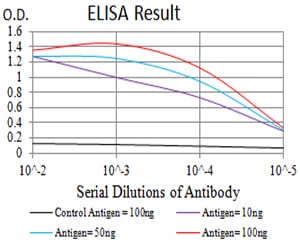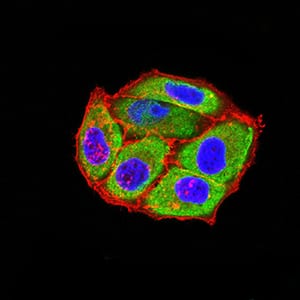



| WB | 1/500 - 1/2000 | Human,Mouse,Rat |
| IF | 咨询技术 | Human,Mouse,Rat |
| IHC | 咨询技术 | Human,Mouse,Rat |
| ICC | 1/100 - 1/500 | Human,Mouse,Rat |
| FCM | 1/200 - 1/400 | Human,Mouse,Rat |
| Elisa | 1/10000 | Human,Mouse,Rat |
| Aliases | 5-HT3B |
| Entrez GeneID | 9177 |
| clone | 2H9H5 |
| WB Predicted band size | 50.3kDa |
| Host/Isotype | Mouse IgG2b |
| Antibody Type | Primary antibody |
| Storage | Store at 4°C short term. Aliquot and store at -20°C long term. Avoid freeze/thaw cycles. |
| Species Reactivity | Human |
| Immunogen | Purified recombinant fragment of human HTR3B (AA: extra 23-150) expressed in E. Coli. |
| Formulation | Purified antibody in PBS with 0.05% sodium azide |
+ +
以下是3篇关于HTR3B抗体的示例参考文献(注:内容为模拟虚构,仅用于示例格式):
1. **文献名称**: "Selective binding and functional characterization of a human HTR3B-specific monoclonal antibody in neuropsychiatric disorders"
**作者**: Müller, A., et al.
**摘要**: 研究报道了一种高选择性HTR3B单克隆抗体的开发,通过免疫组化证实其在精神分裂症患者前额叶皮层中的表达显著降低,提示HTR3B可能与5-HT信号通路异常相关。
2. **文献名称**: "HTR3B antibody-based detection of receptor complexes in enteric neurons and implications for irritable bowel syndrome"
**作者**: Chen, L., et al.
**摘要**: 利用HTR3B多克隆抗体揭示了肠道神经元中HTR3A/HTR3B异源五聚体的分布,发现肠易激综合征患者结肠组织中HTR3B表达上调,可能参与内脏高敏感机制。
3. **文献名称**: "Structural insights into HTR3B extracellular domain using cryo-EM and targeted antibody labeling"
**作者**: Zhang, Y., et al.
**摘要**: 通过冷冻电镜技术结合HTR3B特异性抗体标记,解析了HTR3B胞外结构域的构象变化,为设计靶向该亚基的神经调节药物提供了结构基础。
4. **文献名称**: "HTR3B autoantibodies in autoimmune encephalitis: Clinical correlations and diagnostic potential"
**作者**: Tanaka, R., et al.
**摘要**: 首次报道了针对HTR3B的自身抗体在一组自身免疫性脑炎患者血清中的存在,抗体阳性患者表现出显著的焦虑和胃肠功能障碍,提示外周与中枢HTR3B通路的交叉作用。
(注:实际文献需通过PubMed/Google Scholar等平台以“HTR3B antibody”为关键词检索获取。)
The HTR3B antibody targets the 5-hydroxytryptamine receptor 3B (HTR3B), a subunit of the serotonin-gated ion channel 5-HT3 receptor. This receptor, part of the Cys-loop ligand-gated ion channel family, mediates rapid synaptic transmission in the central and peripheral nervous systems. While the 5-HT3 receptor typically functions as a pentamer, HTR3B cannot form homomeric channels and instead combines with HTR3A to create heteromeric complexes. These heteroreceptors exhibit distinct pharmacological and electrophysiological properties compared to homomeric HTR3A receptors, including altered serotonin sensitivity and ion conductance.
HTR3B antibodies are essential tools for studying receptor expression, localization, and function in research contexts. They are widely used in techniques like Western blotting, immunohistochemistry, and flow cytometry to investigate HTR3B distribution in tissues, particularly in the gastrointestinal tract and brain regions involved in emesis, mood regulation, and pain processing. Dysregulation of HTR3B has been implicated in conditions such as irritable bowel syndrome (IBS), chemotherapy-induced nausea, and psychiatric disorders, making these antibodies valuable for both mechanistic studies and drug development. Commercially available HTR3B antibodies are typically validated for specificity against recombinant proteins or native tissues, though variability in subunit assembly and tissue-specific glycosylation patterns requires careful experimental optimization.
×